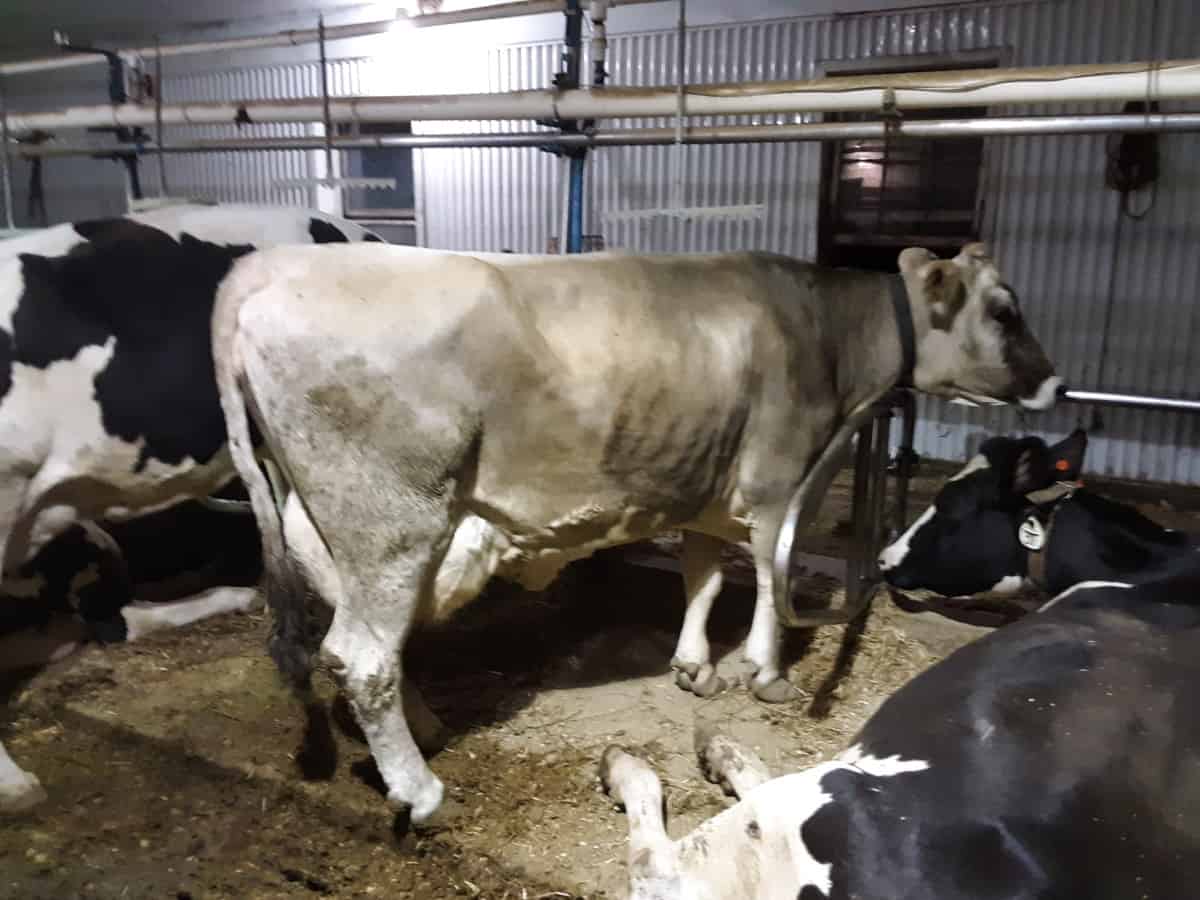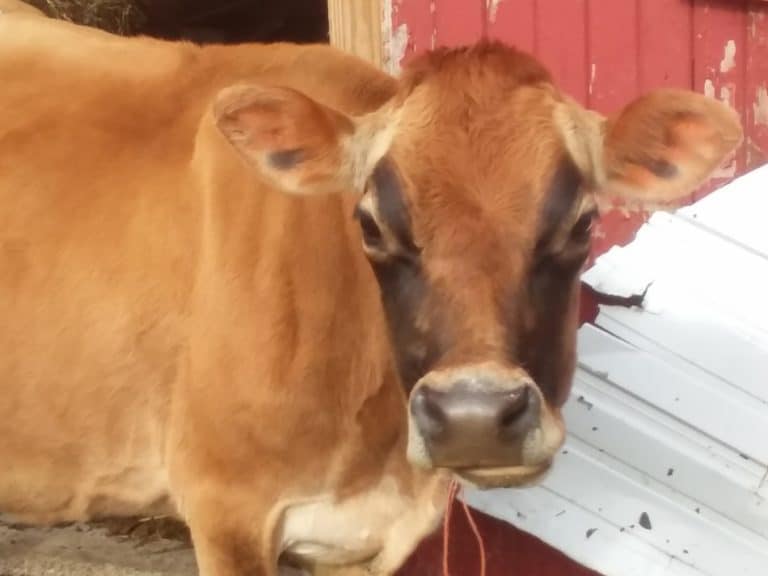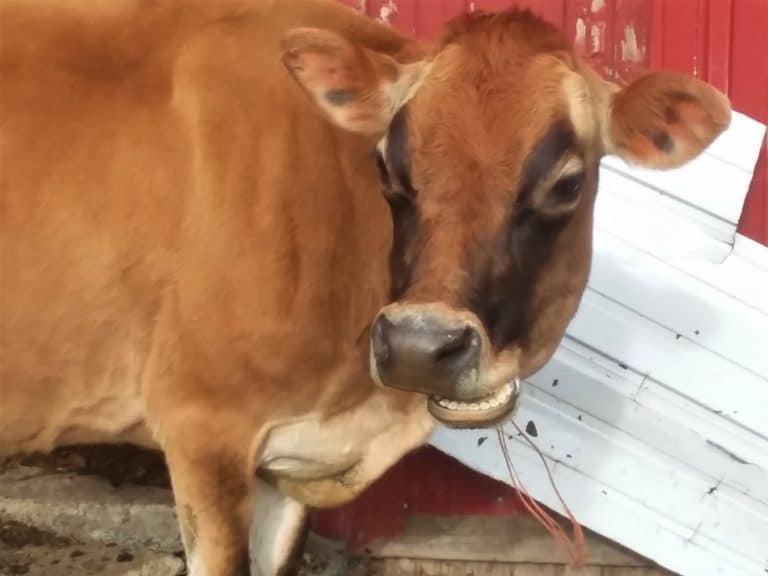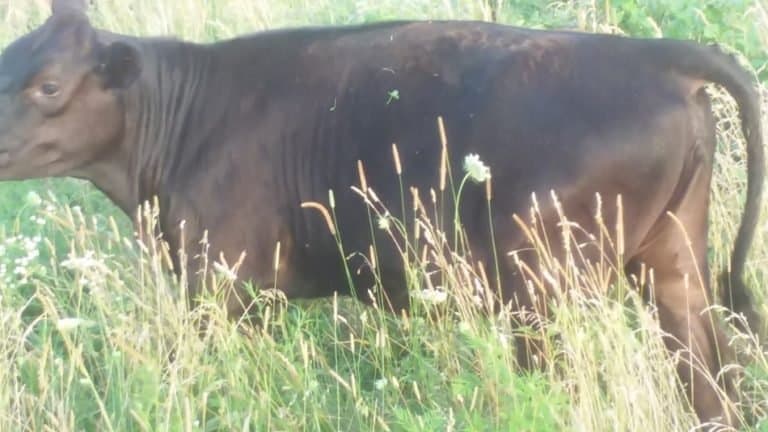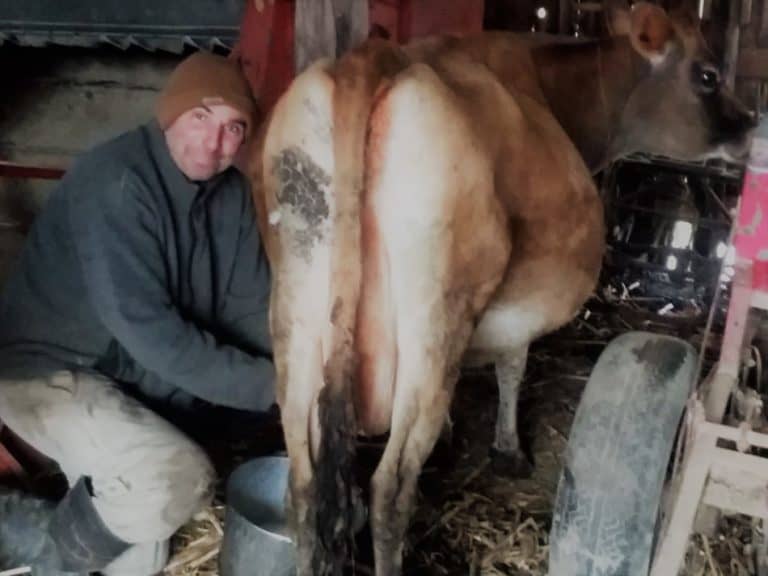91 Facts About Dairy Cattle And Milking Dairy Cattle: Beginner Basics
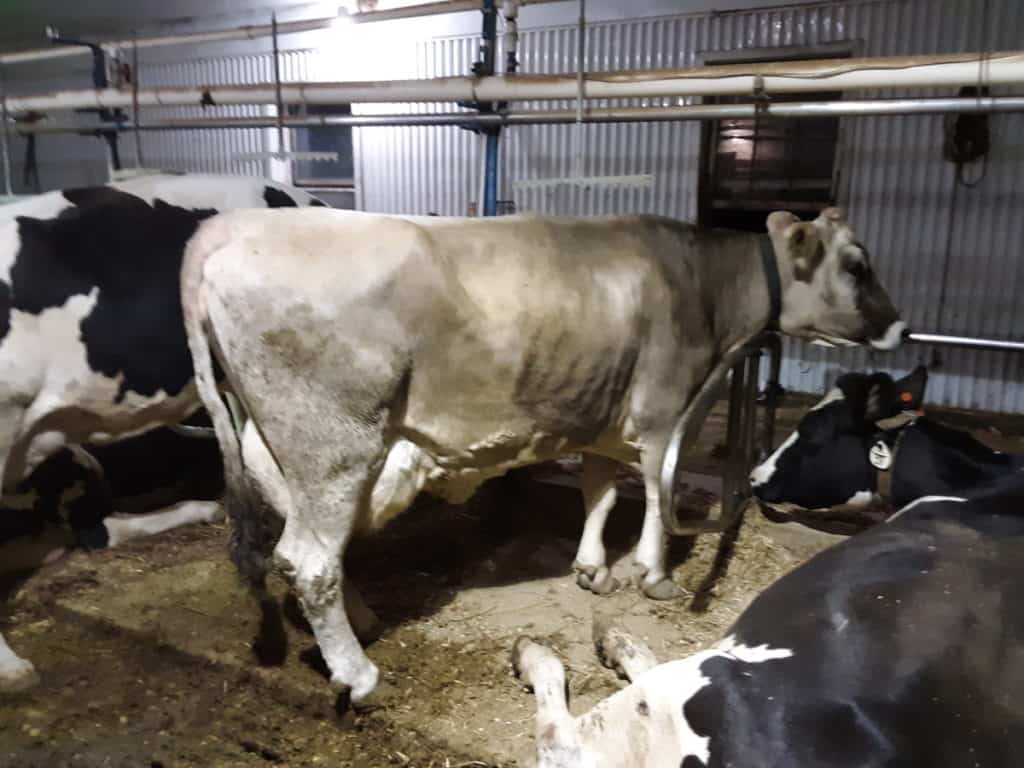
Wondering about the basics regarding dairy cattle?
Terminology and unfamiliar practices used around dairies and dairy cattle can be confusing at first.
No need to worry. This article covers all the terms and ideas you need to know, starting with the absolute basics!
How Much Milk From Your Family Cow? goes over the daily amount of milk you can expect from your cow and how you can be sure to keep her milking well.
How do you know if you’re ready? My guide “Are You Ready For A Family Cow?” will walk you through the things you need to have figured out, including feeding needs and daily care, before you get your cow.
Dairy cattle are mammals.
Dairy cattle and many other animals, like dogs and horses, are mammals. This means that dairy cattle start producing milk to feed a calf after the birth of the calf.
An adult female that has had a baby is called a cow.
The word cow is actually a specific term used only to describe a female bovine that has had a calf, so she is a mom.
A younger female is called a heifer.
A female calf that has not given birth yet is called a heifer. She is called a heifer no matter her size, one day old up to having her first calf she is still called a heifer.
Ideally, a heifer will have her first calf when she turns two years old.
When a heifer is 24 months old (2 years) she will give birth to her first calf. At 24 months she will be a full size animal ready to start milking.
She will have a calf every year as long as she is milking.
Most dairy cows perform best on a schedule of calving every year at about the same time of year.
This yearly calving is part of the natural reproductive schedule of a cow.
Having a baby each year is normal for animals, for example female deer will have a fawn each spring.
A cow produces milk after she has a calf.
Once her calf is born the heifer is now officially a cow. She will be producing milk to feed the calf.
The amount of milk she produces will go up.
Her milk production will go up from the time the calf is born until about two months later, then the amount she milks will gradually go down.
An adult male is called a bull.
Bulls are full size breeding age male dairy cattle.
A young male is called a bull calf.
A younger male that is not castrated is called a bull calf. He is called a calf until he reaches maturity, which varies between breeds.
A castrated bull is called a steer.
A steer is a male calf that has been castrated.
Farmers chose to castrate a bull calf that will be kept for meat in order to avoid the aggressive attitude that can come with some bulls.
A bull calf is castrated when young.
A bull can be castrated at any age, but most farmers will castrate when the calf is young since the calf will be easier to hold.
Husbandry Practices For Raising Dairy Steer Calves is a Michigan State University Extension article giving the basic methods of castration for bull calves.
There are six recognized breeds of dairy cattle in the U.S.
The six recognized breeds of dairy cattle in the U.S. are Holstein, Jersey, Ayrshire, Guernsey, Milking Shorthorn and Brown Swiss.
Any cow breed can be used for milk.
All female cattle produce milk once they give birth, so any cow could be used as a dairy animal.
The recognized dairy breeds are cattle bred to be better at producing milk than most other cattle.
The most popular dairy cow in the world is the Holstein.
The Holstein is the most popular dairy cattle breed in the world.
It’s easy to see why-she can produce the most milk of any breed. To milk well she also must be fed well.
In a situation where the cow would have to find more of her own food and deal with a lot of disease and insect pressure the dairy cow for the local family will have to be a breed that is more able to fend for herself.
5 Best Dairy Breeds For Family Cows shows you my picks of the top breeds you should consider when picking out a family cow.
The Holstein is also the most popular dairy cow in the U.S.
The large herds in the U.S. are all Holstein, since this is the breed that will put the most milk in the tank for the farm to sell.
Different breeds of dairy cattle can live together.
Cattle from different breeds can and often do live together. The only concern is the different sized cattle need different sized sleeping and eating areas.
Most dairy cattle are milked by machine.
Generally, cows in the U.S. are milked by machine if the farm sells the milk to a dairy processor.
Grade A milk (the grade used for fluid milk and yogurt) has to be milked by machine.
Dairy cows can be milked by hand.
Some farmers still milk their cows by hand, specifically the Amish farmers that ship milk in cans. Additionally, many family cows are milked by hand.
We milk ours by hand. If you would like to learn more about hand milking a cow, consider reading my article How To Hand Milk A Cow.
How do you know if you’re ready? My guide “Are You Ready For A Family Cow?” will walk you through the things you need to have figured out, including feeding needs and daily care, before you get your cow.
Cows are milked in a milking parlor.
The parlor is the room in the barn that is dedicated to milking the cows. Most large farms have a raised parlor, this means the cows walk in level, but are actually higher than the people doing the milking.
The difference in levels is so the person putting on the milkers can stand up straight instead of bending over at every cow to put the milker on and to take it off.
Cows get milked two times per day.
Dairy cattle get milked two times per day every day that they are lactating. Some farms choose to milk the herd three times per day, but most do twice.
Milking times are twelve hours apart.
Cows like to be kept on a schedule so they know what is coming up next. Milking cows every twelve hours gives the cow the maximum time to eat and rest between milkings while keeping the milk production high.
The farms that choose to milk three times per day will start milking every eight hours, so at least one milking time is when most people are sleeping.
The building that holds the milking equipment is called the milkhouse.
The small building attached to the milking barn is the milkhouse.
In the milkhouse you will find all of the equipment needed to wash and sanitize the milk lines, run the milk pump and power the bulk tank,
Milk flows by gravity.
When the milk comes from the cow it goes into a stainless steel pipe. The pipe is sloped so that the milk runs to the milkhouse using gravity.
Milk goes to a receiving jar.
All the milk from the parlor flows into a collection jar called a receiving jar. In this jar is a float that rises as the level of the milk in the jar rises.
The milk is pumped from the jar to the tank.
When the float in the receiving jar gets high enough it triggers a pump that takes the milk over head in a pipe to the bulk tank.
The receiving jar will pump many times every milking sending a few gallons of milk at a time into the bulk tank.
The milk tank is refrigerated.
Milk comes from the cow warm since the body temperature of a cow is warm. The milk needs to be immediately cooled to 38 degrees.
The milk tank called a bulk tank can tell the temperature of the milk and will automatically cool it down. Just like your refrigerator turns on once in a while on its own to keep your food cold.
The tank automatically stirs the milk.
In addition to the cooling of the milk the tank will also automatically stir the milk.
This is done with a big paddle that comes down from the top of the inside of the tank. The paddle is on a timer to stir the milk several times eac hour.
The milk needs to be stirred since it is not yet homogenized.
The milk in the tank is straight from the cow and milk straight from the cow will naturally separate, meaning the cream will rise to the top.
The milk you buy at the store has been homogenized so it will not separate.
The milk will be picked up by a hauler.
Every day or every other day (depending upon the size of the milk tank) a tank truck will come and pick up the milk.
A big hose is attached to the valve on the tank and the milk is pumped over to the truck.
The milk will go to a dairy processor.
Most dairy farms will sell their milk to a dairy processor to be bottled or made into cheese or yogurt.
A few farms process and bottle their own milk for customers to buy right at the farm.
Starting to milk is called milk let down.
When the cow starts to milk this is called milk let down. She has learned to let down her milk when she comes into the parlor.
The cow controls milk let down.
The cow controls the let down of milk. Milk let down is controlled by hormones.
If she is stressed or in heat she will not let down her milk as well as she would normally.
Happy cows make more milk.
Happy cows are less stressed. Cows that are less stressed make more milk.
Milk production in dairy cattle is measured in pounds.
Milk production in dairy cattle is measured in pounds. There are eight pounds in a gallon of milk.
Since most dairy cattle are milked twice per day, her daily milk production is for two milkings, one in the morning and one at night.
Milking is called lactation.
Lactation is the word used to describe a mammal producing milk for a period of time.
Lactation periods are ten months long.
Dairy cows tend to do best on a ten month milking schedule. This will keep her productive and at her best health.
Lactation Curve (Milk Production) For Your Family Cow shows you how to plan for the milk you’ll get from your cow.
Each cow gets two months off of milking every year.
Every cow gets time off from milking. Think of it like you getting a vacation from work or school. Cows get a two month vacation every year.
A cow is dry when she is not milking.
When a cow is not milking she is referred to as a dry cow. This means that she is currently on her two months off dry period and will resume milking when she has her next calf.
The dry period helps her rest up before the next calf.
Milking is the job of a dairy cow. The dry period is when she takes a vacation from work to rejuvenate so when she has her next calf she will be at her best.
The average milk production of a Holstein is 23,713 pounds.
This makes her the highest producing dairy breed. 23,713 pounds equals nearly ten gallons of milk per cow per day.
The highest producing U.S. Holstein cow is from Wisconsin.
Selz-Pralle Aftershock 3918 set the world milk production record in 2017 by producing 78,170 pounds of milk in a year.
This is more than three times the amount of an average cow of her breed!
Holsteins are black and white in color.
The Holstein is nearly always black and white. Occasionally, a red and white calf is born but this coloration is relatively rare.
Holsteins are the largest dairy breed.
The average Holstein cow will weigh 1,500 pounds and bulls will top the scales at 2,200 pounds.
Holsteins are originally from the Netherlands.
The Holstein breed is originally from the Friesian region of the Netherlands and a Germany.
Holsteins were imported in larger numbers in 1877 and none have been imported since 1905.
Average Holstein milk has 3.93% butterfat.
Holsteins produce more volume of milk than any other breed but the milk is not as rich.
The average Jersey cow produces 15,593 pounds of milk.
This makes her the one of the lowest producing dairy breed in terms of milk volume.
Jerseys are the smallest dairy breed.
Of the recognized dairy breeds the Jersey is the smallest in terms of weight and height.
Most adult Jersey cows will weigh 1,000 pounds with the bulls weighing 1,600 pounds.
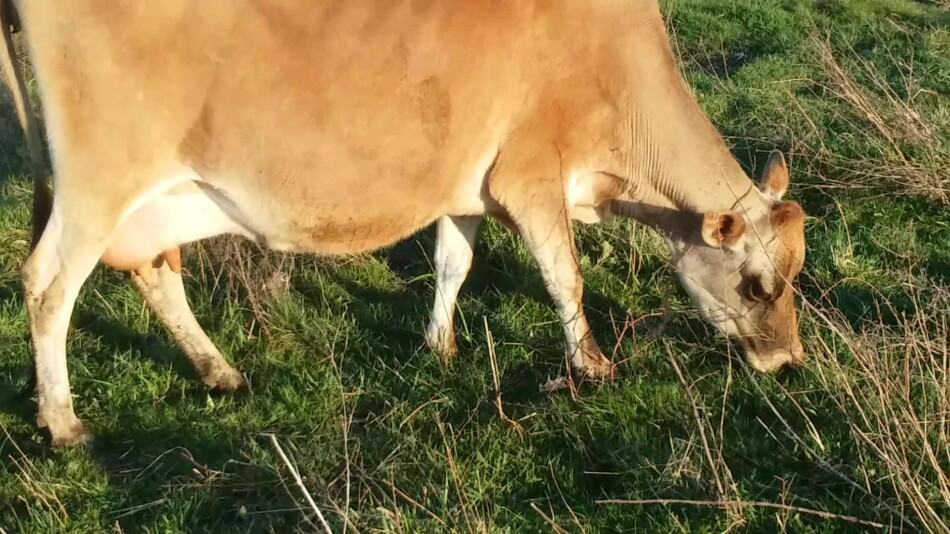
Most Jerseys are brown.
Most Jersey cattle are any where from light to dark brown in body color. There are a few with spots and some that are nearly black.
Jerseys have a dished face and darker hair on the face legs and tail. Our Jersey cow, Aleene, (pictured above) has the classic Jersey coloring.
Jerseys are from an island.
Jersey cattle get their name from the island in the English Channel, also named, Jersey where they are originally from.
Jerseys have the richest milk of any dairy breed.
Jersey cattle are known for having the richest milk of any of the main dairy breeds.
This means that if you were to separate the milk off into all the parts it is made of a gallon of Jersey milk has less water than the other breeds gallon of milk.
Need A Family Cow? goes over 12 breeds of family cow candidates, the Jersey and a few others dairy breeds, and gives tips on considering them as a good family cow prospect or not. Jerseys make a great family cow!
Jerseys average 5.07% butterfat and 3.82% protein milk.
Jerseys produce the richest milk of all the major dairy breeds. Farmers that want higher component milk will have a herd of Jerseys.
Jersey milk is the most commercially valuable in terms of money per gallon.
Farmers are paid for the milk their cows produce. But all milk is not equal in terms of pay.
Higher component milk (less water per gallon) will get the farmer more pay per gallon.
The average Ayrshire cow produces 17,807 pounds of milk at 4.14% butterfat and 3.37% protein.
This puts her as the third most productive breed, in terms of volume, of the main dairy breeds.
Ayrshires are from Scotland.
Ayrshires are from the county of Ayr in southwestern Scotland.
Ayrshires are red and white.
The coat of an Ayrshire is always red and white. The red is referred to as cherry red when it is a warm red.
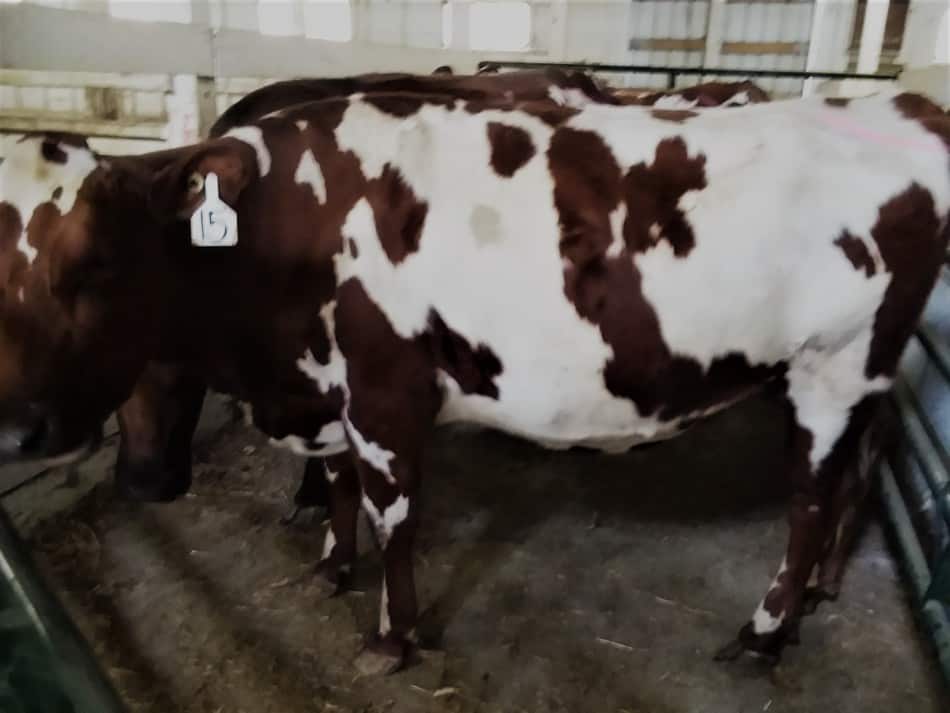
Ayrshire cattle are known for being good grazers.
Ayrshire cattle are vigorous and strong. They also are good at getting out to the field and eating plenty of grass.
The average Guernsey cow produces 16,290 pounds of milk at 4.77% butterfat.
Guernseys are a wise choice for the farmer looking for a higher component cow, the second highest components of all the breeds, that is calm and adaptable.
The Guernsey is from an island.
Right along side the home of the Jersey is the Isle of Guernsey, which is the home of the Guernsey diary cattle breed.
The Isle of Guernsey is a Channel Island off the coast of France.
Guernseys are tan and white.
Guernseys are fawn (tan) to light orange and white in color. They do not have any black hair.
Guernseys are famous for golden colored milk.
Golden Guernsey Milk is a famous phrase noting the tendency of Guernsey milk to have a golden tint.
This means that butter made from Guernseys is naturally golden in color.
Guernseys are known for being gentle.
Guernseys are a gentle cow that is becoming more popular. They are the second most frequently registered cow in the U.S.
Milking Shorthorns are from England.
Milking Shorthorns are originally from the northeastern part of England in the Valley of the Tees, near Scotland.
An old name for Milking Shorthorn is Durham.
Durham was a name used for the Milking Shorthorns when they were imported in 1783. They were also referred to as Milk Breed Shorthorns.
Milking Shorthorns come in red, white, and roan.
Milking Shorthorn cattle can be any combination of red and white, but never they have any black hairs.
Milking Shorthorns can be all white, all red, red and white in patches of color, or roan which is red hairs and white hairs mixed throughout the coat making the cow look pink.
The average milk production of a Milking Shorthorn is 15,450 pounds of milk with 3.91% butterfat and 3.3% protein.
These numbers make the Milking Shorthorn the lowest producing dairy breed listed.
Milking Shorthorns are easy to keep dairy cattle.
Some farms need a cow to be able to graze well, breed back reliably and easily adapt to local conditions.
A cow that a produces crazy amount of milk also needs a crazy amount of feed. Not all farms have the ability to support super high production cows.
Milking Shorthorn is the least popular diary breed.
Milking Shorthorns are not a common breed. It is rare to see a herd of these cattle but there are a few.
Milk production of a Brown Swiss averages 19,387 pounds at 4.2% butterfat and 3.37% protein.
This level of production puts Brown Swiss at the second most productive cow in terms of volume of milk produced per cow.
Brown Swiss cattle are light to dark brown.
Brown Swiss are always brown in body color with black hooves and nose. The body color can range from light brown, called fawn, to dark brown.
Brown Swiss are from Switzerland.
Brown Swiss are originally from the Alps region of Switzerland and are one of the oldest dairy breeds.
Brown Swiss dairy cattle are famous for having an easy going attitude.
Brown Swiss are quiet and docile cattle that tend to live long lives. They are also a bigger breed and tend to mature more slowly than smaller dairy breeds.
Cows can digest food that humans can not digest.
Cattle can digest food, like grass, that a person can not digest. You could eat the grass or hay but you can not get the nutrition from it like a cow can.
Cows are ruminants.
A ruminant is an animal that has a four compartment stomach and will chew it’s cud. Other ruminants include sheep and deer.
Cows turn grass and hay into milk.
With her special stomach a cow can turn grass and hay into milk. She naturally ferments the grass in her stomach giving all of her intestinal bacteria time to work.
The bacteria break down the cell walls of the plants so she can use the nutrients inside.
Cows do not need grain to milk.
Cows will milk without grain. This is because they are ruminants that can get all of their nutrients from grass. For instance, beef cattle routinely raise their calves without any supplemental grain.
Milk production with out grain will be very low.
Our family cow gives us more than enough milk without the use of grain, but she is being cared for as more of a pet than a working dairy cow.
If we were still milking cows for a living we would be feeding some grain to make sure the cow gets all of the nutrients she needs each day.
Grain for a high producing cow is provides the high calorie diet she needs to be most productive.
Dairy cows are commonly fed silage.
Many dairy farms in the U.S. feed silage. This is corn stalks chopped up with the ear (the part that has the yellow kernels of corn) and put in a pile or silo to ferment.
Fermenting preserves the silage.
Dairy cattle also eat haylage.
Some farmers also make haylage, a wet baled hay that will ferment so it will keep.
Silage and haylage are common in countries that do not have good weather to dry hay so the hay is harvested as haylage instead.
Dairy cows drink a lot of water.
A dairy cow that is milking needs quite a bit of water every day.
She will need to drink 50 gallons each day to be able to digest her food and keep hydrated to stay healthy.
Dairy cow poop is called manure.
Manure is the poop from the cows and calves on the farm. Manure is very valuable as a soil builder and as a way to keep or increase the fertility on a farm.
Manure needs and production for each farm vary.
The farmer needs to be sure that the manure is returned to the land to help improve soil fertility. Too much or too little manure on an area will cause problems.
Cattle are herd animals.
All cattle are herd animals, whether dairy or beef breed. A cow feels more secure in a group of peers.
Many herds use A.I.
A.I. in cattle terms is Artificial Insemination.
In A.I. a technician, or a farmer who has learned how, uses straws of semen to breed cows that are in heat. This involves more time spent observing the cows to tell which ones are in heat.
When using A.I. the farmer is safer in the pens with the cattle, since there is no longer a need for a bull to be on the farm.
A.I. gives nearly unlimited choices of genetics.
The main reason A.I. is so popular with commercial cattle farms, both dairy and beef, is that by using A.I. the farmer can get the best bull for each cow to hopefully improve the herd in the future.
This is especially important if the cows in the herd have a variety of traits or if the herd is made of multiple breeds that the farmer would like to keep separate.
A.I. would also allow the farmer to crossbreed specific cows.
Many dairy farmers choose to cross breed their cattle to make a tougher cow or to try to improve a specific trait, for example Holstein Jersey cross cows are a common choice.
This would increase the components in the milk of the crossbred heifer, however it will also decrease milk volume since the cross will be a little above average of the parents.
Another crossbreeding option that has become very popular recently is to breed the dairy cattle to a beef breed bull. This is what we do.
It gives us the option to use the calf as more of a beef type brood cow if it is a heifer and a nice meatier type steer if the calf is a bull.
Additionally, any crossbred animal has the benefit of hybrid vigor, which is that the hybrid is more hardy and faster growing than either of the purebred parents.
When a cow is done milking for her lifetime she is butchered.
When a cow stops being a productive member of the herd she will become part of the food chain.
22.7% of the meat available in stores in the U.S. is from dairy cattle.
Some of the meat sold in the grocery store is from dairy cattle, especially the ground beef. In the U.S. 22.7% of beef in the supply chain is from dairy cattle.
There are companies promoting beef specifically from dairy cows since they have more flavor than meat from younger cattle.
Most dairy cows will spend their days eating and resting.
The bulk of a cow’s day is spent resting and chewing her cud. She will also spend a good amount of time eating.
A cow chews her cud when she is resting.
When you see a cow chewing her cud you can tell that she is relaxed and comfortable.
Her cud is food she is rechewing.
Cud is food that she is rechewing to grind it into smaller pieces. The bacteria in her stomach can work more efficiently with smaller pieces of food.
Resources: Drovers.com, Canadian Dairy Information Center 2017 Dairy Breeds Comparison Chart
Related Questions
Are beef cattle ruminants?
All cattle breeds, both beef and dairy are ruminants.
What is the best breed of dairy cattle?
There is not a best breed of dairy cattle for everyone. The best breed of dairy cattle for you will depend upon your farm and your management.
